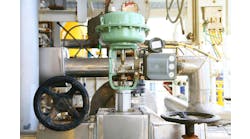Check out ControlGlobal.com on Google+ and Keith Larson's Google+ profile.
Long before the now ubiquitous smartphone and tablet began to empower mobile knowledge worker of all stripes, there was IntelaTrac, the Wonderware mobility solution for roving plant operators in the power, refining and chemical industry. Indeed, IntelaTrac's mobility solutions for workflow, data collection and decision support now are in daily use by some 25,000 field workers at more than 400 plant sites worldwide, according to Steve Moses, vice president of operations, mobility and asset performance for Invensys Operations Management (IOM).This week at the IOM conference for users of IntelaTrac solutions in Houston, Moses, together with other Invensys product managers and advanced users of IntelaTrac solutions, marked the continuing evolution of IntelaTrac from simply documenting operators' routine inspections of plant assets to a mobile, integrated extension of other plant management systems and applications.
Recent Development Efforts
Much of the IntelaTrac development team's recent effort has focused on user requests for increased reliability, dependability and usability of the system, continued Dave Dollar, senior product manager.
Specifically, the platform's latest releases have enhanced security and system administration through Microsoft Active Directory integration to improve handling of permissions, passwords and encryption. The ability to capture and attach images to IntelaTrac notes as well as improvement to SAP and Maximo work notifications have been released. And the ability to "assign assets at run-time" is currently under development for release next year, and should save users time and boost flexibility when it comes to setting up IntelaTrac procedures, Dollar said.
Other enhancements under development for future release include a move to Invensys' unified information management and reporting schema, which is based on Microsoft's SQL Server Integration Services (SSIS) technology. Incorporation of the Invensys ArchestrA model-driven workflow framework and geospatial tracking also are in the works, Dollar said.
Improved Extensibility
Many of these architectural improvements are being undertaken with an eye toward improved integration with other plant "Systems of Record," or SoRs, to support management of change methodologies, according to Moses. For example, integration with scheduling systems such as Primavera and Microsoft Project will enable mobile management of capital project and turnaround activities, Moses said.
For example, tighter integration with other plant systems holds the potential to automatically create procedures in the IntelaTrac system, the motivation being to save time relative to manual procedure creation and instill "greater confidence that as meta data change in the SoR, they will cascade properly into IntelaTrac," Miller said.
Other extensibility benefits include the inclusion of operations and maintenance procedures written in Microsoft Word or Excel, and work procedures directly from maintenance systems. "You want to bring in the information that you want to reference during rounds, such as setpoints from control systems," Miller said.
Other applications include external initiation of inspections and exception reporting for assets deemed critical to production, environmental or safety performance. "We can be pressing the boundaries of collaboration with external systems and even organizations," Miller said. "It's a great opportunity to drive efficiency and eliminate errors."
Ultimately, Miller envisions the potential delivery of the IntelaTrac platform as a cloud-based application managed by Invensys on behalf of its clients. Especially smaller plants with fewer internal resources, might just say: "Send me my handhelds," Miller said.





